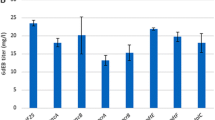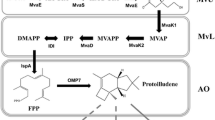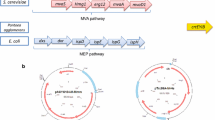Abstract
Enhancement of the cellular exportation of heterologous compounds is an important aspect to improve the product yield in microbial cell factory. Efflux pumps can expel various intra- or extra-cellular substances out of microbial hosts and increase the cellular tolerance. Thus in this study, by using the hydrophobic sesquiterpene (amorphadiene) and diterpene (kaurene) as two model compounds, we attempted to improve isoprenoid production through systematically engineering the efflux pumps in Escherichia coli BL21(DE3). The pleiotropic resistant pumps, AcrAB-TolC, MdtEF-TolC from E. coli and heterologous MexAB-OprM pump from Pseudomonas aeruginosa, were overexpressed, assembled, and finely modulated. We found that overexpression of AcrB and TolC components can effectively enhance the specific yield of amorphadiene and kaurene, e.g., 31 and 37 % improvement for amorphadiene compared with control, respectively. The heterologous MexB component can enhance kaurene production with 70 % improvement which is more effective than TolC and AcrB. The results suggest that the three components of tripartite efflux pumps play varied effect to enhance isoprenoid production. Considering the highly organized structure of efflux pumps and importance of components interaction, various component combinations were constructed and the copy number of key components AcrB and TolC was finely modulated as well. The results exhibit that the combination TolC and TolC and AcrB improved the specific yield of amorphadiene with 118 %, and AcrA and TolC and AcrB improved that of kaurene with 104 %. This study indicates that assembling and finely modulating efflux pumps is an effective strategy to improve the production of heterologous compounds in E. coli.






Similar content being viewed by others
Reference
Ajikumar PK, Xiao WH, Tyo KE, Wang Y, Simeon F, Leonard E, Mucha O, Phon TH, Pfeifer B, Stephanopoulos G (2010) Isoprenoid pathway optimization for Taxol precursor overproduction in Escherichia coli. Science 330(6000):70–74
Aono R (1998) Improvement of organic solvent tolerance level of Escherichia coli by overexpression of stress-responsive genes. Extremophiles 2(3):239–248
Asako H, Nakajima H, Kobayashi K, Kobayashi M, Aono R (1997) Organic solvent tolerance and antibiotic resistance increased by overexpression of marA in Escherichia coli. Appl Environ Microb 63(4):1428–1433
Chang MCY, Eachus RA, Trieu W, Ro DK, Keasling JD (2007) Engineering Escherichia coli for production of functionalized terpenoids using plant P450s. Nat Chem Biol 3(5):274–277
Deininger KNW, Horikawa A, Kitko RD, Tatsumi R, Rosner JL, Wachi M, Slonczewski JL (2011) A requirement of tolC and MDR efflux pumps for acid adaptation and GadAB induction in Escherichia coli. PLoS One 6(4):e18960
Dunlop M (2011) Engineering microbes for tolerance to next-generation biofuels. Biotechnol Biofuels 4(1):32
Dunlop MJ, Dossani ZY, Szmidt HL, Chu HC, Lee TS, Keasling JD, Hadi MZ, Mukhopadhyay A (2011) Engineering microbial biofuel tolerance and export using efflux pumps. Mol Syst Biol 7
Hasdemir U (2007) The role of cell wall organization and active efflux pump systems in multidrug resistance of bacteria. Mikrobiyol Bul 41(2):309–327
Keeney D, Ruzin A, McAleese F, Murphy E, Bradford PA (2008) MarA-mediated overexpression of the AcrAB efflux pump results in decreased susceptibility to tigecycline in Escherichia coli. J Antimicrob Chemother 61(1):46–53
Li XZ, Nikaido H (2009) Efflux-mediated drug resistance in bacteria: an update. Drugs 69(12):1555–1623
Nishino K, Senda Y, Hayashi-Nishino M, Yamaguchi A (2009) Role of the AraC-XylS family regulator YdeO in multi-drug resistance of Escherichia coli. J Antibiot 62(5):251–257
Ostash I, Rebets Y, Ostash B, Kobylyanskyy A, Myronovskyy M, Nakamura T, Walker S, Fedorenko V (2008) An ABC transporter encoding gene lndW confers resistance to landomycin E. Arch Microbiol 190(1):105–109
Papadopoulos CJ, Carson CF, Chang BJ, Riley TV (2008) Role of the MexAB-OprM efflux pump of Pseudomonas aeruginosa in tolerance to tea tree (Melaleuca alternifolia) oil and its monoterpene components terpinen-4-ol, 1,8-cineole, and alpha-terpineol. Appl Environ Microb 74(6):1932–1935
Peralta-Yahya PP, Zhang F, Del Cardayre SB, Keasling JD (2012) Microbial engineering for the production of advanced biofuels. Nature 488(7411):320–328
Poole K (2005) Efflux-mediated antimicrobial resistance. J Antimicrob Chemother 56(1):20–51
Qiu J, Zhuo Y, Zhu D, Zhou X, Zhang L, Bai L, Deng Z (2011) Overexpression of the ABC transporter AvtAB increases avermectin production in Streptomyces avermitilis. Appl Microbiol Biotechnol 92(2):337–345
Ro D-K, Paradise EM, Ouellet M, Fisher KJ, Newman KL, Ndungu JM, Ho KA, Eachus RA, Ham TS, Kirby J, Chang MCY, Withers ST, Shiba Y, Sarpong R, Keasling JD (2006) Production of the antimalarial drug precursor artemisinic acid in engineered yeast. Nature 440(7086):940–943
Sambrook JDWR (2001) Molecular cloning: a laboratory manual, 3rd edn. Cold Spring Harbor Laboratory, Cold Spring Harbor
Shah AA, Wang C, Chung YR, Kim JY, Choi ES, Kim SW (2013) Enhancement of geraniol resistance of Escherichia coli by MarA overexpression. J Biosci Bioeng 115(3):253–258
Sharff A, Fanutti C, Shi J, Calladine C, Luisi B (2001) The role of the TolC family in protein transport and multidrug efflux. Eur J Biochem 268(19):5011–5026
Sulavik MC, Houseweart C, Cramer C, Jiwani N, Murgolo N, Greene J, DiDomenico B, Shaw KJ, Miller GH, Hare R, Shimer G (2001) Antibiotic susceptibility profiles of Escherichia coli strains lacking multidrug efflux pump genes. Antimicrob Agents Chemother 45(4):1126–1136
Tenover FC (2006) Mechanisms of antimicrobial resistance in bacteria. Am J Med 119(6, Suppl 1):S3–S10
Tikhonova E, Yamada Y, Zgurskaya H (2011) Sequential mechanism of assembly of multidrug efflux pump AcrAB-TolC. Chem Biol 18(4):454–463
Tikhonova EB, Dastidar V, Rybenkov VV, Zgurskaya HI (2009) Kinetic control of TolC recruitment by multidrug efflux complexes. Proc Natl Acad Sci U S A 106(38):16416–16421
Tikhonova EB, Zgurskaya HI (2004) AcrA, AcrB, and TolC of Escherichia coli form a stable intermembrane multidrug efflux complex. J Biol Chem 279(31):32116–32124
Touzé T, Eswaran J, Bokma E, Koronakis E, Hughes C, Koronakis V (2004) Interactions underlying assembly of the Escherichia coli AcrAB-TolC multidrug efflux system. Mol Microbiol 53(2):697–706
Tsuruta H, Paddon CJ, Eng D, Lenihan JR, Horning T, Anthony LC, Regentin R, Keasling JD, Renninger NS, Newman JD (2009) High-level production of amorpha-4,11-diene, a precursor of the antimalarial agent artemisinin, in Escherichia coli. PLoS One 4(2):e4489
Walsh C (2000) Molecular mechanisms that confer antibacterial drug resistance. Nature 406(6797):775–781
Acknowledgments
This work was supported by the National Basic Research Program of China (“973” Program, grant no. 2012CB721104), the National High Technology Research and Development Program (“863” Program, grant no. 2012AA02A701), the National Natural Science Foundation of China (grants no. 31170101 and 31100073), “Technology Innovation Action Plan” Key Project of Shanghai Science and Technology Commission (grant no. 10dz1910100), and the major Projects of Knowledge Innovation Program of Chinese Academy of Sciences (grant no. KSCX2-EW-J-12).
Author information
Authors and Affiliations
Corresponding author
Rights and permissions
About this article
Cite this article
Wang, JF., Xiong, ZQ., Li, SY. et al. Enhancing isoprenoid production through systematically assembling and modulating efflux pumps in Escherichia coli . Appl Microbiol Biotechnol 97, 8057–8067 (2013). https://doi.org/10.1007/s00253-013-5062-z
Received:
Revised:
Accepted:
Published:
Issue Date:
DOI: https://doi.org/10.1007/s00253-013-5062-z




